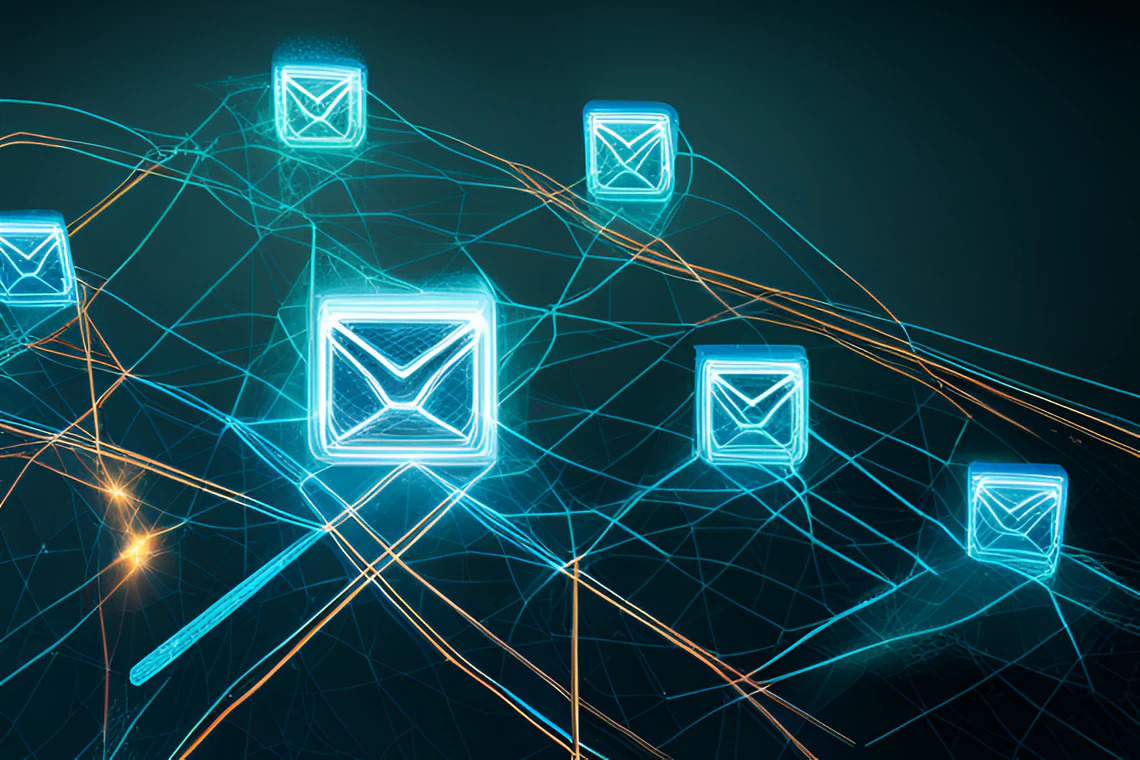
Streamlining Email Integration
Why We Built Mailsnag At Mailsnag, we embarked on a mission to simplify the intricate process of managing SMTP …

Emails have become an essential means of communication in both personal and professional settings. But have you ever wondered what happens behind the scenes when you hit that send button?
Email headers play a crucial role in the delivery process and contain valuable information about the origin, path, and content of an email. Understanding email headers can help you troubleshoot delivery issues, identify spam emails, and ensure the security of your communications.
In this article, we’ll break down email headers, explore their components, and discuss why they matter in today’s digital landscape.
When you receive an email, you usually see the sender’s name, subject, and body. However, there’s a hidden layer of information that travels along with the email called the email header.
An email header is a block of text that contains detailed information about the email and its journey. It’s like an envelope that holds the email and provides important metadata to email servers and clients.
Let’s take a closer look at the different components you can find in an email header.
The ‘From’ field in the email header contains the sender’s email address. It indicates who initiated the email and provides crucial information for recipients to identify the source.
For example, if you receive an email from “john@example.com ,” the ‘From’ field will contain “john@example.com ” in the email header. This field is usually displayed in the recipient’s email client, allowing them to see who the email is from at a glance.
The ‘To’ field in the email header contains the recipient’s email address. It specifies the intended recipient(s) of the email and helps email servers and clients route the email to the correct destination.
For instance, if you send an email to “jane@example.com ,” the ‘To’ field in the email header will contain " jane@example.com ." This field ensures that the email is delivered to the right person or group of people.
The CC (Carbon Copy) and BCC (Blind Carbon Copy) fields in the email header are used to send copies of the email to
additional recipients.
The CC field allows you to send a copy of the email to other individuals, and their email addresses will be listed in
this field. All recipients in the CC field can see each other’s email addresses, promoting transparency and
facilitating communication among multiple parties.
On the other hand, the BCC field allows you to send a copy of the email to additional recipients without revealing
their email addresses to other recipients. This field is often used when you want to keep certain recipients hidden from
each other or keep their identities confidential.
The Subject field in the email header contains a brief description of the email’s content. It serves as a summary or
title for the email, providing recipients with an idea of what the email is about before they open it.
When you open an email, the Subject field is usually displayed prominently at the top of the email client. It helps
recipients prioritize and organize their emails, making it easier to navigate through their inbox.
The Date and Time fields in the email header indicate when the email was sent. They provide recipients with a
timestamp to track when the email was initiated and how long it took to reach their inbox.
These fields play a crucial role in maintaining a chronological order of emails in the recipient’s inbox. They allow recipients to sort and search for emails based on specific timeframes.
The Importance field in the email header indicates the priority level of an email. It helps recipients identify which
emails require immediate attention or are of high importance.
Email clients often provide visual cues, such as icons or color-coding, to represent the importance level of an email. This feature helps recipients manage their inbox more efficiently and ensures that critical emails are not overlooked.
Now that we’ve explored the different components of email headers, let’s discuss why they matter and how they can benefit you.
Email headers can be a valuable tool for troubleshooting delivery issues. If an email fails to reach its intended recipient, examining the email header can provide insights into what went wrong.
The email header contains a trail of information about the email’s journey, including the IP addresses of the servers it passed through. By analyzing this information, you can identify where the email was delayed or if it encountered any errors along the way.
For example, if you notice a significant delay in email delivery, you can check the ‘Received’ fields in the email header to see how long the email spent at each server. This can help pinpoint the source of the delay and take appropriate action.
Email headers can also help you identify spam emails. Spam emails are unsolicited messages sent in bulk, often with malicious intent.
By examining the email header, you can look for suspicious patterns or inconsistencies that indicate the email might be spam. This includes checking the ‘Received’ fields for unknown or suspicious IP addresses and looking for signs of email spoofing or phishing attempts.
For instance, if you receive an email claiming to be from a reputable company but notice that the IP address in the email header doesn’t match the company’s domain, it could be a sign of a phishing attempt.
Email headers play a crucial role in ensuring the security of your communications. They provide information about the authentication and encryption protocols used during the email transmission.
By examining the email header, you can verify if the email was sent over a secure connection and whether it went through proper authentication checks.
For example, if you see ‘TLS’ (Transport Layer Security) mentioned in the email header, it indicates that the email was transmitted securely. This means that the email content was encrypted during transit, reducing the risk of unauthorized access.
Email headers also contain information related to SPF (Sender Policy Framework), DKIM (DomainKeys Identified Mail), and DMARC (Domain-based Message Authentication, Reporting, and Conformance) – three essential authentication protocols.
SPF allows the domain owner to specify which email servers are authorized to send emails on behalf of their domain. It helps prevent email spoofing and protects the reputation of the domain.
DKIM adds a digital signature to emails, verifying that the email has not been tampered with during transmission. It ensures the integrity of the email’s content and provides a level of assurance that the email comes from the claimed sender.
DMARC builds upon SPF and DKIM by allowing domain owners to define policies for handling emails that fail authentication checks. It helps protect against email phishing and spoofing attacks.
By examining the email header, you can check if SPF, DKIM, and DMARC have been implemented correctly. This ensures that the email is coming from a legitimate source and hasn’t been modified or tampered with.
Email headers can also contain sensitive information that you might want to remove or hide to protect privacy and confidentiality.
For example, the ‘Received’ fields in the email header can reveal the IP addresses of the servers the email passed through. These IP addresses can potentially disclose the location or identity of the sender.
If you’re concerned about your privacy, you can use email services or tools that allow you to anonymize or obfuscate the email header. This helps protect your identity and prevents unauthorized access to your personal information.
Now that you understand the importance of email headers, let’s discuss how you can view them in popular email clients and web-based email services.
To view the email header in Gmail, open the email you want to inspect and click on the three dots (More) next to the
reply button. From the dropdown menu, select Show original.
This will open a new tab displaying the email’s raw source, including the email header. You can scroll down to view the complete email header.
In Outlook, open the email you want to examine and click on File in the toolbar. Then, select Properties from the
dropdown menu.
In the Properties dialog box, you’ll find the email header under the Internet headers section. You can select the
text and copy it to analyze or share with others.
To view the email header in Apple Mail, open the email you want to inspect. Then, go to ‘View’ in the toolbar and
select Message and All Headers.
This will display the email header at the top of the email body. You can scroll through it to examine the different components and details.
Web-based email services often provide options to view the email header, although the process may vary.
In general, you can look for an option called View Headers, Show Original, or something similar in your webmail
client. This will display the email header in a separate window or tab.
For example, in Yahoo Mail, you can open the email and click on the three dots (More) in the toolbar. From the
dropdown menu, select View raw message.
Email headers are an essential aspect of email communication that often goes unnoticed. They contain crucial information about the email’s origin, path, and content, and can be valuable for troubleshooting, spam identification, and ensuring email security.
By understanding email headers and knowing how to view and analyze them, you can gain valuable insights into your email communications and enhance your overall email experience. So, the next time you receive an email, take a closer look at the email header and unveil the hidden layers of information it holds.
Until next time amigos 🙌

Why We Built Mailsnag At Mailsnag, we embarked on a mission to simplify the intricate process of managing SMTP …

Introduction In the highly competitive market arena, staying ahead of the competition is crucial for business success. …
No credit card required to sign up. All paid plans come with 30 day cancellation and full refund.
Get Started for Free